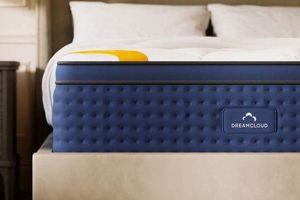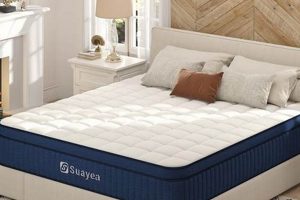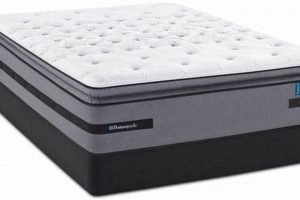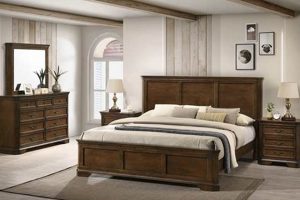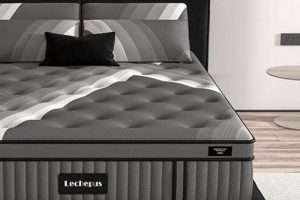The foundation upon which a king-sized mattress rests is a critical component of the sleep system. It provides essential support, ensuring proper weight distribution and contributing significantly to the overall comfort and longevity of the mattress. A poorly chosen foundation can lead to premature wear and tear, impacting the mattress’s ability to provide adequate support.
A stable and well-constructed foundation offers several advantages. It elevates the mattress to a comfortable height, facilitating ease of entry and exit. Moreover, it can enhance airflow, helping to regulate temperature and minimize moisture buildup. Historically, various materials, from simple wooden frames to intricate metal structures, have served as mattress foundations, each offering unique benefits and drawbacks in terms of durability, support, and aesthetic appeal.
The selection of a suitable bed foundation warrants careful consideration, as it directly influences the sleep experience. This article will delve into the various types of support structures available, their respective advantages and disadvantages, and factors to consider when making a purchase decision. It will further explore the impact of the foundation on mattress warranty and overall sleep quality.
Selecting a King Size Mattress Base
Choosing the appropriate base for a king size mattress requires careful evaluation to ensure optimal support, longevity, and overall sleep quality. Consider these factors to make an informed decision.
Tip 1: Assess Mattress Compatibility: Determine the recommended base type for the specific king size mattress. Some mattresses, particularly memory foam or latex models, require a solid, non-slatted foundation for adequate support and warranty validity.
Tip 2: Evaluate Weight Capacity: Confirm that the base can adequately support the combined weight of the mattress and its occupants. Overloading can lead to premature wear and structural failure.
Tip 3: Consider Frame Material and Construction: Opt for a frame constructed from durable materials, such as solid wood or reinforced steel. Examine the joints and connections for stability and long-term reliability.
Tip 4: Measure Available Space: Accurately measure the bedroom to ensure that the selected base fits comfortably, allowing for adequate movement and access.
Tip 5: Examine Support Structure: Inspect the slat spacing of the base. Narrower spacing generally provides better support, preventing mattress sagging and extending its lifespan.
Tip 6: Check for Noise Reduction Features: Look for bases with features designed to minimize noise, such as padded contact points or secure locking mechanisms. Excessive noise can disrupt sleep.
Tip 7: Review Warranty Information: Understand the warranty terms and conditions for both the mattress and the base. A mismatch in warranty requirements could lead to claim denials in case of damage.
Properly selecting the foundation for a king size mattress provides structural support, enhances comfort and extends the lifespan of the mattress, and therefore offers long-term value. Thorough research and consideration of these points will contribute significantly to improving sleep quality.
Following these guidelines will contribute to a more informed decision, maximizing the benefits and minimizing potential drawbacks associated with the purchase of a king size mattress foundation.
1. Support and Stability
The connection between support and stability and a king size mattress foundation is foundational to achieving quality sleep. A king size mattress, due to its substantial dimensions and weight, requires a robust and stable base to prevent sagging, uneven weight distribution, and premature wear. The level of support directly influences spinal alignment; a foundation that lacks adequate support can contribute to back pain and discomfort. For instance, a slatted foundation with excessively wide gaps between slats may cause a memory foam mattress to sag over time, compromising its conforming properties. In contrast, a solid platform foundation provides uniform support, preserving the mattress’s integrity and extending its lifespan. The stability of the base is equally critical, as it minimizes motion transfer. A wobbly or unstable base can amplify movements, disturbing sleep, especially for couples.
The selection of materials and construction techniques significantly impacts the support and stability offered. Steel frames, known for their strength and rigidity, often provide superior support compared to flimsy wooden structures. Reinforced joints and sturdy legs are essential for maintaining stability, particularly under the considerable weight of a king size mattress and its occupants. The design of the foundation also plays a crucial role; some foundations incorporate center support beams to prevent sagging in the middle, a common problem with larger mattresses. Furthermore, the presence of non-slip surfaces or recessed edges can enhance stability by preventing the mattress from shifting during use. Choosing a base which matches a customer’s needs is key to ensuring long-term use of the mattress.
In summary, the support and stability of a king size mattress support are integral to achieving a comfortable and restful sleep experience. The foundation’s ability to uniformly distribute weight, minimize motion transfer, and maintain its structural integrity over time directly impacts the mattress’s performance and longevity. Selecting a foundation engineered for optimal support and stability is a crucial investment in sleep quality and overall well-being. Ignoring this aspect can lead to discomfort, premature mattress wear, and ultimately, a diminished sleep experience.
2. Size and Dimensions
The physical measurements of a king size mattress foundation are critical considerations, directly impacting compatibility, functionality, and overall bedroom aesthetics. Accurate size and dimensional understanding is essential for seamless integration into the intended space and optimal mattress support.
- Standard King Dimensions
The established dimensions for a standard king size mattress are typically 76 inches in width and 80 inches in length. The foundation must adhere to these measurements to ensure proper mattress fit and prevent overhang or insufficient support. Deviations from these standard dimensions can compromise mattress stability and comfort.
- Foundation Height
The height of the foundation influences the overall bed height, affecting ease of access and visual proportions within the bedroom. Low-profile foundations create a more contemporary aesthetic, while taller foundations may be preferred for individuals with mobility concerns or those seeking under-bed storage. The selected height must complement the mattress thickness and user prefe
rences. - Frame Overhang/Recess
Some foundations feature a slight overhang or recess relative to the mattress edge. An overhang can provide a visual frame, while a recess can prevent the mattress from shifting. The design choice is often aesthetic, but it can also impact edge support and the overall appearance of the bed.
- Internal Support Structure Dimensions
The dimensions and spacing of internal support structures, such as slats or metal grids, are crucial for weight distribution and preventing mattress sagging. Wider slat spacing may be suitable for certain mattress types, while others require closer spacing for adequate support. These internal dimensions directly affect the longevity and performance of the mattress.
Proper consideration of these size and dimensional aspects is vital for selecting a king size mattress foundation that meets individual needs and preferences. Accurate measurements, attention to detail, and an understanding of the interplay between foundation dimensions and mattress characteristics are essential for a satisfying and functional sleep environment.
3. Material Durability
Material durability is a paramount consideration in the context of a king size mattress foundation. The extended lifespan and performance of this critical bed component hinges directly on the quality and resilience of the materials used in its construction. A king size mattress, due to its substantial weight and dimensions, exerts significant and continuous stress on its supporting base. Consequently, a foundation constructed from inferior materials is prone to premature degradation, leading to compromised support, structural instability, and ultimately, the need for replacement. For instance, a foundation utilizing low-grade wood may exhibit warping or cracking under the sustained weight of the mattress and occupants, diminishing its ability to provide even support.
The selection of durable materials directly translates to long-term cost savings and enhanced sleep quality. A foundation built with robust materials, such as reinforced steel or kiln-dried hardwood, can withstand years of use without significant deterioration, preserving the mattress’s integrity and preventing sagging. This, in turn, ensures proper spinal alignment and reduces the likelihood of back pain or discomfort. Furthermore, durable materials contribute to the foundation’s ability to minimize motion transfer, providing a more stable and undisturbed sleep environment. A foundation constructed with lower quality material may begin to squeak with movement which disrupts sleep and signals component failure.
In conclusion, material durability is not merely a superficial attribute but rather a fundamental determinant of a king size mattress foundation’s value and performance. The investment in a foundation constructed from high-quality, resilient materials is a strategic decision that yields significant returns in terms of longevity, support, sleep quality, and overall cost-effectiveness. Neglecting material durability can result in premature failure, compromised sleep, and ultimately, a more costly and less satisfying sleep experience.
4. Design Compatibility
The correlation between design compatibility and a king size mattress support is more than aesthetic; it involves ensuring the foundation harmonizes with the mattress’s structural and functional requirements, as well as the overall bedroom decor. A mismatch in design can compromise mattress performance, room aesthetics, and user satisfaction.
- Headboard Integration
A primary aspect of design compatibility is the ability of the foundation to seamlessly integrate with a headboard. Standard king size foundations often include pre-drilled holes or mounting brackets that facilitate attachment to a variety of headboard styles. A foundation lacking this compatibility may necessitate the use of adapters or modifications, potentially compromising the structural integrity or aesthetic appeal of the bed.
- Style and Finish Coordination
The style and finish of the support should complement the overall aesthetic of the bedroom. Whether it is a modern minimalist design or a more traditional style, the foundation’s appearance should align with the existing decor to create a cohesive and visually appealing space. A clash in styles can detract from the overall ambiance of the room. For instance, a rustic wooden foundation may not be suitable for a contemporary bedroom with sleek metal accents.
- Profile Height and Visual Balance
The profile height of the foundation contributes to the overall visual balance of the bed. A foundation that is too high or too low can disrupt the proportions of the room, making the bed appear either disproportionately large or insignificantly small. The selected height should be carefully considered in relation to the ceiling height and the size of the bedroom to achieve a harmonious aesthetic.
- Fabric and Upholstery Choices
Upholstered foundations offer an additional layer of design compatibility. The fabric choice, color, and texture can significantly impact the overall look and feel of the bed. Coordinating the foundation’s upholstery with existing bedding or accent pieces can create a cohesive and stylish sleep environment. Conversely, a poorly chosen fabric can detract from the room’s design and create a visual discord.
Therefore, design compatibility is a crucial element in selecting a king size mattress foundation. Careful consideration of headboard integration, style and finish coordination, profile height, and fabric choices ensures that the foundation not only provides adequate support but also enhances the overall aesthetic of the bedroom. Neglecting these design aspects can result in a visually disjointed and less satisfying sleep environment.
5. Warranty Terms
Warranty terms associated with a king size mattress support are a critical component of the overall purchase. These terms define the manufacturer’s or retailer’s obligations in the event of defects or failures in the base’s construction or performance. A typical warranty outlines the duration of coverage, the types of defects covered (e.g., structural failure, manufacturing flaws), and the remedies available (e.g., repair, replacement). For instance, a warranty may cover the cracking of a wooden frame within a specified timeframe, provided that the base has been used under normal conditions and in accordance with the manufacturer’s guidelines.
The importance of understanding warranty terms is amplified by the potential for mismatch between mattress and bed warranties. For example, a mattress warranty may be voided if the support does not meet specified requirements, such as a minimum number of slats or a specific type of center support. Failure to adhere to these requirements could result in claim denial if the mattress develops sagging or other issues directly attributable to inadequate support. Therefore, consumers must carefully review both the mattress and base warranty documents to ensure compatibility and avoid potential coverage gaps. Practical understanding of t
hese terms guides the consumer towards informed purchasing decisions.
In summary, warranty terms represent a critical component of a king size mattress foundation, defining the scope of protection against defects and failures. A thorough understanding of these terms, including coverage duration, covered defects, and specific requirements related to mattress compatibility, is essential for safeguarding the consumer’s investment and ensuring recourse in the event of product malfunction. Ignoring these considerations can result in uncovered repair costs or even total loss of product use, which reinforces the importance of evaluating warranties before making the final purchase decision.
Frequently Asked Questions
This section addresses common inquiries concerning king size mattress foundations, providing clarity on key aspects related to selection, compatibility, and maintenance.
Question 1: What is the standard size of a king size mattress foundation?
The standard dimensions for a king size mattress foundation are typically 76 inches wide and 80 inches long. Variations may exist, so confirming the precise dimensions before purchase is advisable to ensure compatibility with the mattress.
Question 2: Can any type of frame be used as a king size mattress base?
No, not all frames are suitable for supporting a king size mattress. The chosen base must provide adequate support and stability to prevent sagging and premature wear. Platform beds, slatted frames with sufficient center support, or adjustable bases specifically designed for king size mattresses are generally appropriate.
Question 3: What factors should be considered when choosing a base for a memory foam king size mattress?
Memory foam mattresses often require a solid or closely slatted base to prevent sagging and maintain their supportive properties. Slats should be no more than a few inches apart. It is crucial to check the manufacturer’s recommendations for the specific mattress model to ensure warranty compliance and optimal performance.
Question 4: How does the height of a king size mattress foundation impact comfort?
Foundation height affects the overall bed height, influencing ease of getting in and out of bed. Individuals with mobility limitations may prefer a higher foundation, while others may opt for a lower profile for aesthetic or functional reasons. The optimal height is a matter of personal preference and individual needs.
Question 5: How often should a king size mattress base be replaced?
The lifespan of a king size mattress foundation depends on the materials used, construction quality, and usage patterns. A well-constructed base may last for several years, while a lower quality one may require replacement sooner. Signs of wear, such as sagging, squeaking, or visible damage, indicate the need for a replacement.
Question 6: What is the role of the bed frame in a king size mattress base?
The bed frame provides the external structure that holds the foundation and mattress in place. It often incorporates a headboard and footboard, contributing to the bed’s overall aesthetic. The frame must be sturdy enough to support the weight of the foundation, mattress, and occupants without wobbling or collapsing.
Understanding these aspects of the king size mattress foundation provides a comprehensive insight of support system which ensures proper sleep quality. Proper research and selection are important for a long term satisfaction.
The next section will explore a comparison of different types of king size mattress bases and their respective features.
King Size Mattress Base
This exploration has underscored the vital role a king size mattress base plays in the overall sleep system. Factors such as material durability, support structure, design compatibility, and adherence to warranty terms must be carefully evaluated to ensure optimal mattress performance and longevity. Selecting an appropriate base mitigates the risk of premature mattress wear, promotes proper spinal alignment, and enhances the overall sleep experience.
The selection of a king size mattress base represents a significant investment in long-term sleep quality. A thorough understanding of the considerations outlined herein is crucial for making an informed decision that will contribute to restorative sleep and overall well-being. Continued awareness of evolving technologies and materials in mattress support systems will further empower consumers to optimize their sleep environment.


